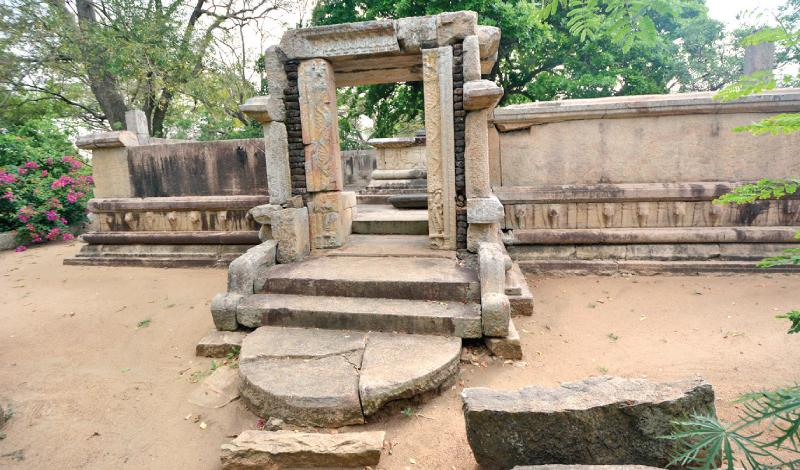
One of the best preserved Bodhi-Gharas (Bo-tree house) in the country is in Nillakgama, Hettigama. Our journey seeking the Bodhi-Ghara, however, had much more than what one would expect - rocky crevices and tanks with blossoming water lilies. To reach the Nillakgama Bodhi-Ghara, we took the Ibbagamuwa-Moragollagama secondary road turning left from Saliyagama and driving down another 18 kilometres on the Galgamuwa road via Ehutuwewa.
The site gets no pilgrims today. It is silent, but in its heyday, this was a main spiritual hub of a sacred Bo-tree worshipping site.
Pink stone structure
We glimpsed the pink stone structure through the branches as the late morning sun’s rays filtered through the huge kone tree at the site.
Nestling in a wooded area beneath the bund of the village tank of Hettigama, the Bodhi-Ghara seems to be made of granite. It belongs to the eigth century BC time span of the Anuradhapura period. Once this place was known as Dalada Maligawa and Pattirippuwa by the village folk in the abandoned village of Nillakgama.
The ruins
Buried deep under the forest, the ruins were examined by H.C.P. Bell, the Commissioner of Archaeology in 1895 with the help of villagers, and his report carried a brief descriptive note supplemented by some fine drawings.
The place was then deserted in the jungle for more than 60 years.
Treasure hunters
 |
| The elaborately carved stone door frame |
Treasure hunters had ravaged the Bodhi-Ghara digging deep pits in the centre and destroying the upper terrace, throwing carved stones about in search of valuable treasure.
Conservation
Again, after more than 60 years, shedding light on Nillakgama in 1954, Prof. Senarath Paranavithana, commenced the conservation of this archaeological site.
He has said, that it was not an easy task to conserve the remaining artefacts and structure which had been ransacked by treasure hunters. The jungle also contributed to the ruin of the monument when the huge branches of a kone tree crashed down damaging the beautiful door-frame of the western side and scattering pieces of the structure.
The shrine was reclaimed and conserved in less than a year by the Department of Archaeology under the supervision of Prof. Paranavithana himself as Commissioner of Archaeology. He was surprised by the creative craftsmanship of this Bodhi-Ghara.
Stone carvings
 |
| The upper platform of the Bodhi-Ghara |
Paying homage inside the shrine on the upper terrace, we observed all the magnificent stone carvings, walking to every nook and cranny of the stone structure considered as one of the best carvings chiseled by Sinhala sculptors.
The most striking feature is that the door frames are elaborately carved while some of the principal designs normally found on the moonstones themselves are absolutely plain. For the most part, one is struck by the simplicity of the building: the wall surface of the parapet is in fact, wholly devoid of ornamentation.
It is not impossible that the Bo-tree which stood at the centre of the upper platform could have sprung from the seeds of the Anuradhapura Bodhi-tree immediately after it was planted in the reign of King Devanampiyatissa.
Shading our eyes against the scorching sun, we gazed at the narrow foot path into the forest in the direction given by a villager. However, venturing in, we were surrounded by stone ruins and mounds of earth where ancient bricks and parts of carved stone altar slabs indicated the grandeur that must have pervaded the stupa adjoining the Bodhi-Ghara at one time.
